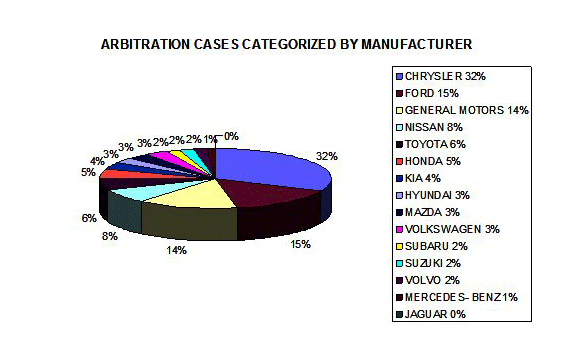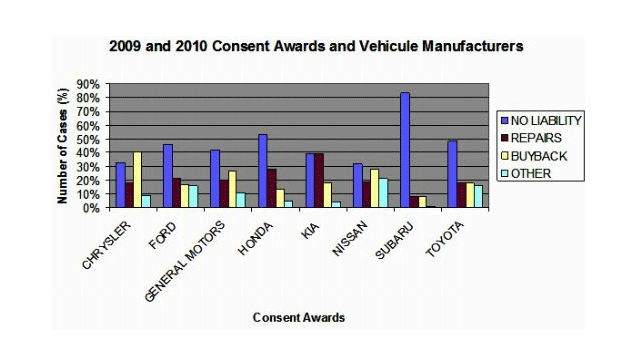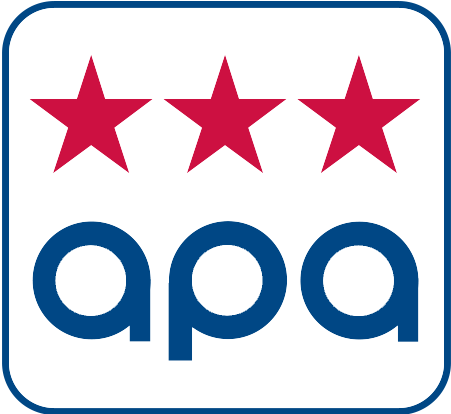The published success rate for consumers is around 61%, but 54% of consent awards and 21% of arbitrated cases were ordered back to the dealer for yet another repair. For many consumers who have gone through the arbitration process, this is not a satisfactory resolution, but in CAMVAP’s statistics they appear as a successful resolution. Some consumers who went through the arbitration process contacted the APA to inform us they wanted the vehicle replaced or a monetary award and were not happy with a return trip to the dealer.
A small number of cases results in a vehicle refund less an allowance for use. More precisely, 1% of consent awards and 12% of arbitrated cases are buybacks with reductions. CAMVAP arbitrators need guidelines for identifying just how bad a vehicle has to be before replacement can be required. Because CAMVAP is an industry-controlled program with weak government and consumer representation, it has successfully avoided introducing guidelines. In the U.S. every state has a lemon law which defines how defective vehicles must be to allow a return.
Depending on whether the vehicle is purchased or a leased, CAMVAP has different formulas for calculating the depreciated value of a vehicle for a cancellation of sale. The leasing formula is generally more generous to the consumer. Essentially, you can walk away from the lease without a payout or penalty for early cancellation.
For the buyback of a vehicle that is not leased, depreciation is calculated using a lifespan of 160,000 km. Average lifetime mileage of a new vehicle is now around 300,000 km, so CAMVAP is discounting the vehicle life by 50% in their calculations. In some cases brought to the APA’s attention, the CAMVAP valuation was not much different from the market value. CAMVAP does not recognize certain dealer-installed accessories: for example, rustproofing and extended warranties are not eligible for refunds. (The extended warranty company may offer a partial refund in the event of a buyback, if no claims have been made under the extended warranty.)
CAMVAP is an alternative to the court system
Consumers have the right to seek rescission of a contract and/or damages through the courts in accordance with the laws in each province. Consumers must choose between CAMVAP or a civil action. The CAMVAP decision is final. You cannot commence a normal civil action after CAMVAP renders a decision. (While CAMVAP decisions are final, they can be reviewed. However, courts are generally reluctant to overturn decisions of arbitrators, who are deemed to have specific expertise and had the opportunity to hear testimony and assess the credibility of witnesses. For an appeal to be successful the consumer would have to show that errors were made of such a high degree that they would require that the decision be reversed or a new hearing ordered.)
CAMVAP is fast
Average time from submission of the request for arbitration until the decision is around 70 days. Administration issues were a major source of the complaints registered in the U.S. in the early days of their auto arbitration programs. CAMVAP is well-run which reduces complaints. With CAMVAP, most people don’t register concerns until after they have received their decision.
CAMVAP stresses it is friendly and free
Consumers reporting to the APA say the hearing was more adversarial than “friendly”. CAMVAP can supply a technical expert at no-charge to the consumer, but that person is not likely to be a mechanic or engineer, and may not have the skills or equipment to diagnose the vehicle. In a technical case, you are much better off to bring your own expert, but CAMVAP’s literature does not tell you this. Here’s what an expert witness wrote to the APA about his two CAMVAP appearances:
- The arbitrators are ultimately paid by the manufacturers and it was obvious from their conduct.
- The manufacturers’ representatives are seasoned, experienced and aggressive. A typical owner who shows up on his or her own without professional legal or expert assistance is likely to be eaten alive.
- The arbitrators knew little about cars, which was to the detriment of the owner.
- The arbitrator is allowed to rule only on whether the vehicle has a manufacturing defect or not. Some complaints are hard to put in one category, as they may involve poor service or communication by the dealer.
- There is no appeal or review.
CAMVAP’s budget is about 1.5 million dollars per year. If we average this amount over the 693 hearings that were held in 2002, the cost per hearing is approximately $2000. Payment to the arbitrator was around $350 for the hearing and writing the decision — a small amount for the work involved, and not a large component of the overall budget. In 2002, approximately $250 000 was set aside for the arbitrators, the rest is for administration of the program. The manufacturers pay the cost of the program. CAMVAP’s budget represents a cost of about $1.00 for every new vehicle sold in Canada.
CAMVAP has one consumer representative (Consumers Association of Canada) and several government reps on its board (British Columbia, Alberta, Saskatchewan, Manitoba, Ontario, Quebec, New Brunswick, Nova Scotia, Prince Edward Island, Newfoundland and Labrador, Yukon Territory, Northwest Territory and Nunavut Territory).
Several shortcomings with the program were corrected only after the Quebec OPC (Office de la protection du consommateur) came on board in early 2000. The Province of Quebec convinced CAMVAP to drop the requirement that consumers keep its decisions confidential – one of many extraordinary restrictions in the program that representatives from consumer ministries across Canada, and the weak consumer representation had been prepared to live with.
Related: CTV Toronto, March 6 2021: Ontario woman says she’s traumatized by new car that randomly slams on the brakes
Arbitration Awards For Each Auto Manufacturer
Frequency of arbitrations by carmaker

APA combined the results for 2009 and 2010 posted on the CAMVAP website. There is a wide variation in the number of arbitration cases for each manufacturer. Chrysler comprises the largest share of arbitration cases with a very substantial 32% share. A review of the complaints reveals a higher number of problems per vehicle for Chrysler products than other brands, with multiple issues per vehicle occurring more frequently.
Ford and General Motors have representations that are reasonably in line with their market shares in Canada. Data for the other manufacturers is too limited for the APA to draw conclusions.
Arbitrations outcomes for each carmaker

Based on the 2009 and 2010 awards data, arbitrators are much more likely to grant consumers a buyback for some manufacturers than others. As depicted in the chart, Chrysler was ordered to buy back its vehicles approximately 40% of the time (the yellow bar in the graph). On the other hand, Subaru has a very low rate of buybacks (just one vehicle in 11 arbitrations) and the highest likelihood of not being liable for the problems with its vehicles. Among the domestics, Ford customers had the lowest likelihood of getting their vehicle repurchased, at just 17%.
Among the import brands, Nissan has the highest frequency of buybacks at 28%. No other import brand attained even 20%. This means that if you’re driving a Ford, or an import other than a Nissan, the overall chance of having a vehicle repurchased is less than one in five arbitrations.
The table below shows the arbitration outcomes for each manufacturer. Among the mass-market brands, BMW, Mitsubishi and Suzuki do not participate in CAMVAP.
Outcomes by manufacturer
| Manufacturer | No Liability | Repairs | Buyback | Other |
|---|---|---|---|---|
| Chrysler | 33% | 18% | 40% | 9% |
| Ford | 46% | 21% | 17% | 16% |
| General Motors | 42% | 20% | 27% | 11% |
| Honda | 53% | 28% | 17% | 5% |
| Kia | 39% | 39% | 18% | 4% |
| Nissan | 31% | 19% | 28% | 21% |
| Subaru | 83% | 8% | 8% | 1% |
| Toyota | 48% | 18% | 18% | 16% |
